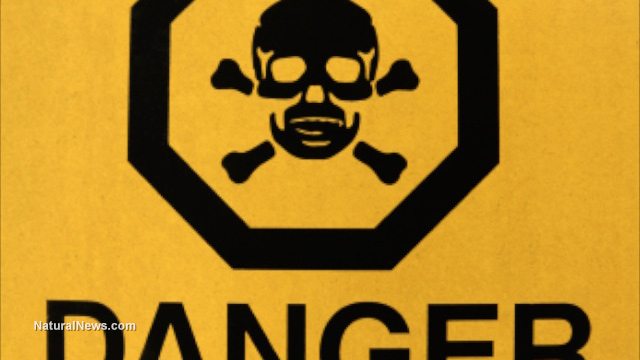DDT still poisons people and wildlife in Michigan 40 years after being banned
Monday, August 11, 2014 by: Julie Wilson
Tags: DDT, wildlife poisoning, Michigan

- Gardening tips: 15 Simple tricks to double your garden’s yield this season
- TAKE IT DOWN Act advances in Congress amid free speech concerns
- Survival 101: Dangerous places to avoid when disaster strikes
- Nature’s arsenal: How plant compounds power military survival and healthcare in crisis
- Kawasaki unveils rideable ROBOT HORSE powered by hydrogen
- Amazon's Kuiper satellite launch delay highlights uphill battle against Musk's Starlink
- DOJ and ATF kill Biden’s “Zero Tolerance” firearms dealer policy
- Criminal referral requests filed against Fauci and top COVID officials in seven states
- Hospital staffers sound alarm after 10 nurses were diagnosed with BRAIN TUMORS
- “Prepare Tribe: Prepare, Protect, Provide” on BrightU: How to build a disaster-proof shelter in the middle of nowhere
- Barley: A nutrient-dense ancient grain with modern benefits
- Germany prepares students for war amid growing security concerns
- New studies ignite debate: Fluoride linked to autism and ADHD, prompting calls for policy reassessment
- Rafael Medoff explores the role of Jabotinsky in the rise of Revisionist Zionism in “Militant Zionism in America”
- Trump escalates tariffs to 145% on Chinese goods amid fentanyl crisis, escalating trade tensions
- Yoga and autism: A science-backed look at how a simple practice is transforming behavior and movement in children with ASD
- POLL: U.S. support for Israel drops to lowest level in decades amid Gaza War
- Sovereign debt paradox: U.S.-China mutual holdings fuel geopolitical tensions
- Tulsi Gabbard leads charge against the Biden regime’s global censorship of the 'Disinformation Dozen'
- Fauci is back in the limelight, and he’s busy promoting a future COVID or FLU pandemic
- Aerosolized bioweapons? Strange “diploid biomasses” falling out of the sky in Florida captured under the microscope
- Analysis: The coming economic collapse, a mass uprising and Trump's three secret weapons to halt the growing revolt
- Widespread social and economic unrest: Steve Quayle issues urgent financial warning of imminent asset collapse in new interview with Mike Adams
- Kiss Your Genetic Privacy Good-Bye! 23andMe Gets Green Light to Sell Your Intimate Genetic Details to Anyone They Want
- Tulsi Gabbard takes aim at censorship: Justice for the ‘Disinformation Dozen’
- Mike Adams releases country western hit single: Goin’ Back in Time is Comin’ Home
- U.S. lawmakers investigate Meta over alleged China collaboration
- CLOT SHOT PLANDEMIC UNFOLDING: Fibrous, rubbery clots caused by covid injections have prion-like seeding activity
- Chemtrails unveiled: How the CIA and Big Business are manipulating the weather for profit
- How Israeli military-connected corporations are secretly controlling your online privacy
- European Court of Justice: Healthcare professionals who promoted or administered COVID-19 vaccines are CRIMINALLY LIABLE for any harm caused
- DEATH by VACCINE or face PRISON time: Canadian Freedom Convoy leaders CONVICTED for protesting forced vaccination during the Covid Plandemic
- Defunding DEADLY mRNA jabs: Government funding for mRNA technology being scrutinized and sidelined until proven "safe and effective" for real
- Federal employees whine over DOGE's new directive requiring them to do a 5-point summary of weekly accomplishments
- U.S. approves new Russian ambassador as diplomatic thaw continues
- Curcumin’s ancient healing power supercharges muscle recovery, and its effects are compounded with anti-inflammatory foods and supplements
- Newly released JFK files reveal Pentagon's role in creating Lyme disease and covid in the same lab
- Analysis: The coming economic collapse, a mass uprising and Trump's three secret weapons to halt the growing revolt
- Mike Adams releases country western hit single: Goin’ Back in Time is Comin’ Home
- Aerosolized bioweapons? Strange “diploid biomasses” falling out of the sky in Florida captured under the microscope
- Kiss Your Genetic Privacy Good-Bye! 23andMe Gets Green Light to Sell Your Intimate Genetic Details to Anyone They Want
- Dr. Mike Yeadon releases 15-minute testimony - WATCH - about genocidal intent of COVID “vaccines”
- Trump reverses course on Gaza plan, says “nobody is expelling Palestinians”
- MEDICAL BOMBSHELL: FDA admits Covid mRNA 'Vaccines' CAUSE CANCER
- European Court of Justice: Healthcare professionals who promoted or administered COVID-19 vaccines are CRIMINALLY LIABLE for any harm caused
- The Health Ranger releases “Vaccine Zombie” song and music video, using AI-animated zombies for the music video
- 5 Simple steps to boost your brainpower: How to strengthen executive function in a distracted world
- A lack of integrity in Academia: Harvard professor found GUILTY of fraudulent research to promote CRT theory
- Federal employees whine over DOGE's new directive requiring them to do a 5-point summary of weekly accomplishments
- EPA advisor admits the agency is funneling billions to climate groups ahead of Trump’s return to White House
- California's social media censorship law struck down: A victory for free speech or a threat to online safety?
- Space war brewing? Russia threatens to destroy Starlink satellites
- Survival 101: Effective EMF blocking techniques
- Rep. Nancy Mace introduces bill to ban biological males from female facilities on federal property
- Red Cross issues warning to stop blood plasma donations from vaccinated people
- Scientists confirm: GENIUS brain function can be spontaneously unleashed in humans without any apparent cause
- EPA advisor admits the agency is funneling billions to climate groups ahead of Trump’s return to White House
- HYSSOP: What research reveals about the health benefits of this ancient holy herb
- Two containers with completed ballots fall out of truck in Florida
- Newly released JFK files reveal Pentagon's role in creating Lyme disease and covid in the same lab
- Global leaders unite to clamp down on “misinformation” with UN-backed Cascais Declaration
- BREAKING: 2025 NDAA authorizes mandatory military draft of WOMEN across America… as Pentagon pursues global NUCLEAR war with both Russia and China at the same time
- Michael Yon warns of a ZIONIST TAKEOVER in Trump’s second administration
- Ozempic and Wegovy weight loss drugs are injectable LIZARD VENOM PEPTIDES that may unleash a devastating wave of organ failure… side effects align with symptoms of SNAKE BITES
- The Health Ranger releases “Vaccine Zombie” song and music video, using AI-animated zombies for the music video
- Mike Adams releases country western hit single: Goin’ Back in Time is Comin’ Home
- BOMBSHELL: DNA testing kits are a SCAM to develop ethnic-specific bioweapons
- Israeli soldiers accused of even more torture and abuse in the West Bank
- These 13 countries just signed an agreement to engineer a global FAMINE by destroying food supply
- NASA admits that climate change occurs because of changes in Earth’s solar orbit, and NOT because of SUVs and fossil fuels
- Fully vaccinated about to see “tsunami” of illness and death, warns virologist
- RFK Jr. clears key hurdle: Sen. Susan Collins backs controversial HHS nominee, signaling a new era for health policy
St. Louis, located within Gratiot County, is home to about 7,500 residents. The picturesque town is a classic example of Middle America and is home to the historic Magnetic Mineral Springs. Discovered in the late 19th century, the springs put the town on the map, transforming it into a destination hotspot for those seeking healing from the local mineral-rich water.
Town formerly known for mineral-rich healing water is now site of DDT contamination
Unfortunately, just a few decades later, Velsicol Chemical Corp., formerly known as Michigan Chemical, opened and began producing various pesticides including DDT, an extremely poisonous compound that's been banned for use in the United States for over 40 years.
The 54-acre plant was forced to close its doors following the revolutionary book Silent Spring, authored by Rachel Carson, which highlighted the hazardous effects of toxic chemicals like DDT, particularly in birds.
Velsicol was the sole manufacturer of two pesticides prominently featured in Silent Spring, which subsequently led to an outright ban on the chemicals, forcing the plant's closure.
The plant also produced polybrominated biphenyls, or PBBs, a chemical flame retardant that became mixed up with cattle feed in 1973, leading to the poisoning of thousands of cattle and other livestock. More than 500 farms were quarantined, and residents across the state were exposed to the PBBs, which have been linked to cancer, reproductive complications and endocrine disruption.
The site is now one of the costliest superfund sites in America, and arguably one of the most deadly. In 1982, the Environmental Protection Agency (EPA) took control of the site, demolishing the plant in the late 1990s; however, a thorough cleanup has not been performed, leaving the areas that are much dependent on the Pine River completely contaminated. To this day, fishing is still banned in the river.
The most common complaint heard from St. Louis residents regarding the superfund site is the unsightly death of the area's beautiful song-singing birds. "It's like they are having a convulsion, and then they're dead," said Jim Vyskocil, a St. Louis resident who admits that he's watched robins fall from the sky and flop around until their death for many years now.
Matt Zwiernik, an environmental toxicologist with Michigan State University, collected 29 dead birds last year from a nine-block residential area near the superfund site, conducting a forensic study of bird carcasses.
His results were alarming.
Brain and liver abnormalities were found in 12 of the 29 birds. The mean total level of DDT or DDE (a breakdown component of DDT) in the bird's brains was 552 parts per million, some of the highest concentrations ever recorded in wild birds, according to Zwiernik.
100 percent of the dead birds contained extremely high levels of DDT
Scientists confirm that just 30 parts per million of DDT can be fatal to a variety of bird species.
"The local residents, they are not surprised; they know what's going on. They've seen it for 20 years," said Zwiernik. "I think it's the rest of the world that's shocked that there's a situation in this day and age where a larger portion of the city has such contamination that birds are falling from the sky."
The Detroit Free Press reports that the birds' sudden death is reportedly due to ingesting contaminated worms, grubs and insects poisoned by DDT in the area's soil.
The EPA, which is now in control of the site, is working over the next two years to remove contaminated soil up to four feet deep from nearly 100 residential yards near the site. Around 30,000 tons of soil is expected to be removed by the summer's end.
Following its bankruptcy, Velsicol only provided $20 million toward its cleanup; however, the scope of the damage is closer to half a billion dollars.
Additional sources:
http://www.scientificamerican.com
http://www.beyondpesticides.org
http://www.beyondpesticides.org
http://www.epa.gov
http://www.freep.com
http://www.stlouismi.com
http://science.naturalnews.com
DDT at FETCH.news
Get independent news alerts on natural cures, food lab tests, cannabis medicine, science, robotics, drones, privacy and more.
Take Action: Support Natural News by linking to this article from your website
Permalink to this article:
Embed article link: (copy HTML code below):
Reprinting this article:
Non-commercial use OK, cite NaturalNews.com with clickable link.
Follow Natural News on Facebook, Twitter, Google Plus, and Pinterest
Science News & Studies
Medicine News and Information
Food News & Studies
Health News & Studies
Herbs News & Information
Pollution News & Studies
Cancer News & Studies
Climate News & Studies
Survival News & Information
Gear News & Information
News covering technology, stocks, hackers, and more



"Big Tech and mainstream media are constantly trying to silence the independent voices that dare to bring you the truth about toxic food ingredients, dangerous medications and the failed, fraudulent science of the profit-driven medical establishment.
Email is one of the best ways to make sure you stay informed, without the censorship of the tech giants (Google, Apple, Facebook, Twitter, YouTube, etc.). Stay informed and you'll even likely learn information that may help save your own life."
–The Health Ranger, Mike Adams













































